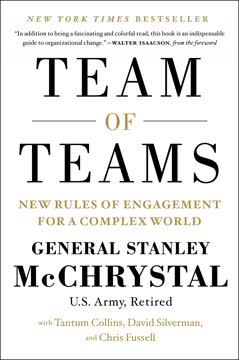Key Takeaways
1. Military revolutions, driven by technology, offer first-movers decisive advantages and increase in frequency.
History shows that a military that first masters the new form of warfare enjoys a clear and potentially decisive advantage over its rivals.
Quantum leaps in effectiveness. Military revolutions represent disruptive shifts in the character of warfare, yielding a significant boost in military effectiveness, often by an order of magnitude or more. These periods of rapid change have become more frequent over the past two centuries, largely driven by rapid advances in technology.
First-mover advantage. Militaries that successfully identify and exploit these disruptive changes before their rivals can achieve quantum leaps in effectiveness, leading to major shifts in the balance of power. Examples include:
- Prussia's use of railways, rifles, and telegraph in the 1860s.
- Germany's integration of aviation, mechanization, and radio (Blitzkrieg) in 1940.
- The U.S. introduction of nuclear weapons in 1945.
High stakes competition. Failing to keep pace during a military revolution risks operating at a severe disadvantage. The competition is intense, and "silver medals are not awarded to those who come in second."
2. The Precision-Warfare Revolution is maturing, ending U.S. dominance and creating contested operational environments.
Now, however, the precision-warfare regime is reaching its mature stage.
From nascent to mature. The Precision-Warfare Revolution, characterized by battle networks directing extended-range scouting and strike forces (reconnaissance-strike complexes), was introduced by the U.S. military in the First Gulf War. For roughly two decades, the U.S. held a near monopoly on this capability.
Rivals catch up. Other military powers, particularly China, have now acquired most of the capabilities that enabled U.S. dominance. This marks the mature stage of the revolution, where at least two major powers possess these capabilities.
New challenges for the U.S. The U.S. military spent decades perfecting warfare against minor powers in "permissive" environments. Meanwhile, China and Russia focused on countering U.S. power projection, developing sophisticated anti-access/area-denial (A2/AD) reconnaissance-strike complexes designed to operate in "non-permissive" environments.
3. A new military revolution is emerging, fueled by technologies like AI, hypersonics, and synthetic biology.
Even as the precision-warfare regime matures, a new military revolution is emerging.
Overlapping revolutions. As the current precision-warfare regime reaches maturity, rapid advances in a range of technologies are setting the stage for a new, overlapping military revolution. This pace is accelerated by the intensifying competition between the U.S., China, and Russia.
Key enabling technologies:
- Artificial Intelligence (AI)
- Additive Manufacturing (3D printing)
- Synthetic Biology (e.g., CRISPR)
- Quantum Computing (QC)
- Directed Energy (DE)
- Hypersonic Weapons
Commercial sector drivers. As with previous revolutions, many of these advances are driven primarily by the commercial sector, making their development and diffusion potentially faster and harder to control.
4. Successful disruptive innovation requires a clear, guiding vision of future warfare and novel operational concepts.
The objective here is more modest: to identify some salient characteristics of the maturing precision-warfare regime, while offering some informed speculation on the features of an overlapping successor revolution.
Beyond technology. Disruptive innovation is not just about acquiring new technology; it's about translating emerging technologies into new sources of advantage through innovative operational concepts – new ways of fighting.
Guiding questions. Militaries that lead the way have a clear vision addressing:
- What are we trying to do? (The operational challenge)
- How can we accomplish this in a far more effective way? (The operational concept)
Focus and direction. A clear vision, even if initially incomplete, provides focus for analysis, war-gaming, exercises, and investment, preventing efforts from dissolving into confusing and incompatible projects.
5. Effective military adaptation demands rigorous exercises, experimentation, and learning from both success and failure.
Yet they represent a significant improvement over informed speculation.
Beyond theory. While analysis and war-gaming are important, they cannot replace the detailed insights gained from well-designed field exercises and fleet maneuvers that simulate combat conditions.
Identifying details and friction. Exercises reveal the practical challenges and "friction" that simulations miss, helping to refine operational concepts and identify key performance metrics. Examples:
- Royal Navy fleet maneuvers revealed limitations of torpedo-boat destroyers and challenges of long-range gunnery.
- German Army exercises with dummy tanks and motorized units vetted Blitzkrieg concepts.
- U.S. Navy Fleet Problems refined carrier operations and task force organization.
- U.S. Air Force Red Flag exercises exposed training gaps and validated SEAD concepts.
Building support. Realistic exercises also build support within the officer corps for new concepts, convincing skeptics in a way that theoretical arguments cannot.
6. Winning future conflicts prioritizes speed, range, scouting, and precision over traditional armor and mass.
Since the dawn of the industrial age, we’ve seen great advances in military capabilities, including increases in the speed and range of systems and communications, in scouting and counter-scouting capabilities, in protective armor, and in massed and precision fires.
Enduring trends. Across military revolutions since the mid-19th century, successful adaptation has generally involved prioritizing:
- Speed: Faster movement, faster engagement cycles.
- Range: Striking from greater distances.
- Scouting/Counter-scouting: Finding the enemy while avoiding detection.
- Precision: Accurate fires over sheer volume.
Declining relative value. Conversely, the relative value of heavy armor and massed firepower has generally declined, though not uniformly or absolutely.
New domains reinforce trends. The expansion of warfare into domains like air, space, cyber, and undersea, which inherently favor speed, range, stealth, and information, reinforces these trends.
7. Successful innovation is institutionalized through long-tenured leaders who cultivate future proponents.
In this environment the ability to innovate and adapt quickly would logically assume a much greater priority than it enjoyed during the Cold War.
Sustaining momentum. Disruptive innovation is a long process, typically taking a decade or more. Leaders driving such change need extended tenure to build momentum and overcome resistance.
Cultivating acolytes. Visionary leaders cultivate and promote like-minded officers who will carry the vision forward after the leader departs. Examples:
- Admiral Fisher and his "Fishpond."
- General von Seeckt and the preservation of the General Staff core.
- Admiral Moffett and the creation of a naval aviator career path.
- General Creech and the development of future TAC/Air Force leaders.
Institutionalizing change. These leaders work to embed the new concepts and priorities within the organization's structure, training, and culture, ensuring the change outlasts their tenure.
8. Investment strategies must hedge against uncertainty by creating options and avoiding premature commitment to specific systems.
Which emerging technologies will mature when expected and as expected?
Uncertain future. Predicting which technologies will succeed, when, and how they will combine is impossible. Militaries must invest under conditions of deep uncertainty.
Hedging through options. Successful strategies involve hedging against this uncertainty by:
- Investing in a range of promising technologies and concepts ("wildcatting").
- Avoiding large production runs of systems before they are proven or if technology is rapidly changing ("false starts").
- Divesting from obsolete or ineffective systems ("dogs").
Time-based advantage. The ability to develop and field new capabilities rapidly allows a military to delay large commitments, observe rivals, and adapt quickly, effectively buying options on the future.
9. Time-based competition—the ability to innovate and adapt faster than rivals—is crucial during disruptive shifts.
Victory will smile upon those who anticipate changes in the character of war, not upon those who wait to adapt themselves after changes occur.
Agility is key. The ability to develop, test, and field new capabilities and doctrine more quickly than rivals provides a significant competitive advantage, especially during periods of rapid change.
First vs. second mover. Superior time-based competition allows a military to:
- Exploit a "first-move" advantage by introducing a new way of fighting before rivals can react.
- Leverage a "second-move" advantage by quickly catching up to and surpassing a rival's initial innovation.
Efficiency in time. Faster development and fielding reduce the risk of investing in systems that become obsolete before they provide value.
10. The democratization of destruction, enabled by technology, empowers small groups and complicates security.
Humankind’s character is not improving at anything close to the rate of its capacity for destruction.
Lowering barriers. Advances in technology, particularly in cyber, biological sciences (CRISPR), and unmanned systems (drones), are dramatically lowering the technical and capital barriers to inflicting significant destruction.
Empowering non-state actors. Capabilities once limited to major states are becoming accessible to smaller groups and even individuals, increasing the potential for mass killing or disruption by non-state entities.
New threats. Examples include:
- Drone swarms capable of overwhelming defenses.
- Sophisticated malware for ransomware or critical infrastructure attacks.
- Synthetically engineered "precision" biological weapons.
Challenges for deterrence. This diffusion of destructive power complicates deterrence, especially against actors who may not be rational or who lack a fixed address to target for retaliation.
11. Deterrence is eroding in a multipolar world with blurred lines between conventional and strategic capabilities.
Thus far the chief purpose of our military establishment has been to win wars. From now on the chief purpose must be to avert them.
Multipolar complexity. The rise of multiple great powers and the proliferation of advanced capabilities increase the potential points of failure for deterrence strategies.
Blurred firebreaks. Advances in precision conventional weapons capable of strategic effects and the development of low-yield, "discriminate" nuclear weapons are blurring the distinction between conventional and nuclear conflict, increasing the risk of escalation.
Attribution challenges. In domains like cyber, space, and biosciences, identifying the source of an attack quickly and definitively is difficult, undermining deterrence based on the threat of retaliation.
Human factors. Deterrence strategies often assume rational actors, but human decision-making is influenced by bounded rationality, prospect theory (framing effects, endowment effect), optimism bias, and cultural differences, making deterrence less reliable, especially against risk-tolerant leaders.
12. The U.S. military currently lacks key characteristics needed for successful disruptive innovation and rapid adaptation.
Yet attempting to predict with precision how any technology will shape the military competition is an impossible task.
Absence of clear vision/concepts. The U.S. military currently lacks a clear, prioritized set of operational challenges and corresponding innovative operational concepts to guide its adaptation efforts, often resorting to abstract or consensus-driven processes.
Slow acquisition and adaptation. The U.S. military's acquisition system is characterized by being slow and expensive, hindering its ability to compete based on time and rapidly field new capabilities.
Short-tenured leadership. Senior civilian and military leaders often rotate through key positions too quickly to provide the sustained focus and cultivation of proponents needed for large-scale disruptive innovation.
Lack of realistic joint exercises. Despite the need to adapt to contested environments and multi
[ERROR: Incomplete response]
Last updated:
Review Summary
The Origins of Victory is praised for its insightful analysis of military innovation and its impact on great powers. Readers appreciate Krepinevich's historical case studies and their relevance to current military challenges. The book's exploration of disruptive technologies and their potential to reshape warfare is highlighted. Some criticize the dense writing and occasional redundancy, while others find value in the author's expertise and thought-provoking ideas. Overall, reviewers consider it an important contribution to military literature, despite some structural and focus concerns.
Similar Books







Download PDF
Download EPUB
.epub digital book format is ideal for reading ebooks on phones, tablets, and e-readers.




